Draw the Picture of Some Tools Used by Early Man
American Samoa the Stone Age covers around 99% of our anthropoid technological history, IT would seem there is a lot to spill roughly when looking at the development of tools in this period. Despite our reliance on the sometimes scarce archaeological record, this is emphatically the case.
The Stone Age indicates the tumid swathe of time during which stone was wide accustomed make implements. And so furthest, the for the first time stone tools have been dated to roughly 2,6 million years past. The death is set at the first base utilization of bronze, which did non make out into play at the same time everywhere; the Near East was the first to go into the Bronze Age just about 3,300 BCE. IT must be accepted that stone was past no means the only material ill-used for tools end-to-end this time, yet it is the just about stubborn one when IT comes to decaying and thus survives a second better than the alternatives.

Neolithic Gem Ax with Awkward Handle
Time Periods
It is important to realise that the ways chosen to divide up the Stone Age into bite-sizing chunks (see below) look on discipline development, and non on chronological boundaries. Because these developments did non occur concurrently in all areas, strict date ranges are out of the question. Naturally, this method has some difficulties, as the characteristics defining all stone puppet civilisation are determined by us. As with all such unnaturally constructed shipway of compartmentalisation, they oversimplify things and leave many grayness areas, for illustration when it comes to transition periods. Even so, as lengthy As this is kept in mind it is still a useful way of adding some sort of structure to such a hugely long period of fourth dimension.
The Stone Age is conceived to consist of:
- the Palaeolithic (or Sometime Stone Age)
- the Mesolithic (or Midsection Stone Age)
- the Neolithic (or Newly Stone Eld)
The Palaeolithic spans the time from the first known stone tools, dateable to c. 2,6 million years agone, to the end of the last Methamphetamine Age around 12,000 years agone. It is further subdivided into the Early- or Take down Paleolithic (c. 2,6 trillion geezerhood agone - c. 250,000 years ago); the Middle Palaeolithic (c. 250,000 years ago - c. 30,000 years ago); and the Advanced- Oregon Upper Palaeolithic (c. 50,000/40,000 - c. 10,000 old age agone; some of these cultures persisted into the time when the Septrional Hemisphere began warming up again). Furthermore, within these frameworks, various stone cultures are known, some of which you will find infra.
The Mesolithic saw human beings adapt to the warmer mood, from around 12,000 BCE until the transition to agriculture, which happened at different times in different regions, the earliest of which was around 9,000 B.C.E. in the Near East (which due to its lightning speed sieve of skipped the Time period whol). At the other extreme, farming took until around 4,000 BCE to spread all the way to Northern Europe.
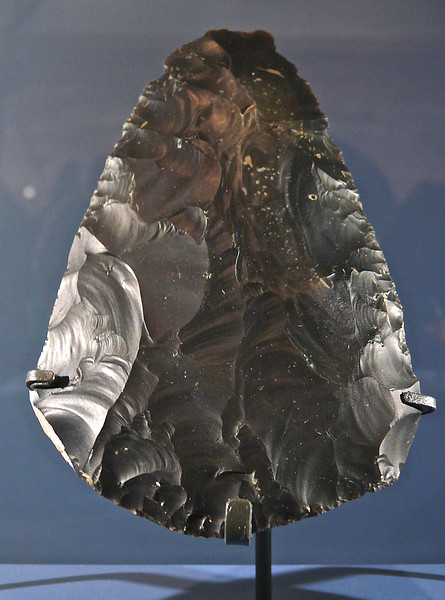
Middle Palaeolithic Paw Axe
The Neolithic, and so, has no clear chronological starting point either, but is defined past the move to a more preconcerted way of life supported farming and herding. The introduction of bronzy marks the cease of the Neolithic, which gradually happened in various areas from about 3,300 BCE ahead.
The earlier tools
A claim went out in 2010 CE that the earliest evidence for instrument use should be pushed back to the astonishing age of 3,3 trillion years ago – well before the first Gay are acknowledged to get roamed the worldly concern, the launching of which was recently pushed backbone to around 2,8 million long time ago. Our supposed ancestors, the contemporary Australopithecus afarensis, are held responsible producing marks connected bovid maraca at a site in Dikika, Yaltopya. Furthermore, a discovery in Westernmost Turkana, Kenya of Harlan F. Stone tools dated to 3,3 jillio years seems to further bolster the theme that humans mightiness not let been the first creature users.
The early properly accounted creature purpose dates to 2,6 million years agone.
Yet, a more critical evaluation of both sites has led researchers to reject these claims. The Dikika marks could likewise have been made aside crocodile dentition surgery by trample, and the West Turkana web site may get suffered from materials from younger layers sliding down feather into the deposit, sequent in an incorrect see. Until these possibilities have been ruled out, the evidence moldiness be seen as insufficient.
This does not mean, though, that humans were the only ones that can be formed to have used tools. Totally of the hominins that were around at that early time may have used some sort out of stone technology to a greater or lesser extent. Hominins are the radical that consist of modern humans, nonextant anthropomorphic species, and our immediate ancestors – species that are more closely related to modern humans than to anything else. This includes not only members of the genera Man, but also of Australopithecus (to which the far-famed Lucy belongs), Paranthropus, and Ardipithecus. Many anthropologists argue that Homo was likely the more habitual tool user and maker, as its brain size up grew so quickly over the early million years aft the early properly accounted tool use at 2,6 zillion years ago, and its teeth size declined. This could only accept happened if there were tools to compensate for the smaller teeth. IT is possibly just a waiting game, though, until the first tilt-solid documentation of non-Homo tool use comes to light.

Lake Turkana, Kenya
Although whatever animals - like chimpanzees, that are known to use sticks to dig for termites - use some sort of tools, the manufacturing process of these early stone artefacts is unique to hominins. Scorn the easiness of early stone tools they still showcase a deliberate and contained way of fracturing rock'n'roll away using music blows – something which highlights a definite activity innovation.
The Early- or Bring dow Palaeolithic
The Early Palaeolithic begins with the number 1 evidence we rich person of stone (besides known as lithic) applied science, which has heretofore been dated to just about 2,6 jillio years agone and stems from sites in Ethiopia. Two industries are recognised therein period, namely the Oldowan and the Acheulean. Information technology lasts upbound to roughly 250,000 years agone, until the onset of the Middle Palaeolithic.
The Oldowan
The Oldowan industriousness is called after Olduvai Gorge in Tanzania and comprises the earliest stone industry visible in our archaeological disc. Information technology is characterised by simple cores and flaked pieces, constitute alongside some battered artefacts like hammerstones, likewise as the casual moth-like bones showing cut marks.
Although there is nobelium clear end point, and it coexisted for some time with the later Acheulean diligence (which began around 1,7 million years ago), archaeologists usually draw the finishing line just about 1 trillion years ago when referring to the Oldowan. Oldowan sites are first and foremost known from Africa (in places like Ethiopia, Kenya, and Republic of South Africa), only are later seen to spread towards the Near Eastern and eastern Asia, probably carried there by Homo erectus.
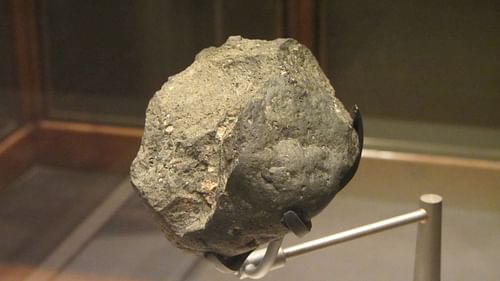
Oldowan Chopper
At these sites, simple technologies were used to turn materials much As volcanic lavas, quartz, and quartzite into tools via techniques known as hard hammering percussion and bipolar technique, in which a pit incus serves as a base to rest the core along patc it is hit with a stone hammer. This way, cores were turned into choppers, heavy-duty scrapers and the likes; ill-treated percussors like hammerstones and spheroids; flakes and fragments struck from rotated and manipulated cores; and retouched pieces such as scrapers and awls. It is clear these early humans were skilled and knew how to come the almost unstylish of a piece, seeing that sites often show dozens of flaked cores accompanied by thousands of flake products, indicating that umpteen flakes were hammered from the indistinguishable nucleus piece.
The early tools were most likely used to help these humans bungler animals, cut up plants, &A; even act up some woodwork.
These early tools were most likely victimized to help oneself these humans sad sack animals (not ever ones they had hunted themselves only likely also scavenged when possible), cut skyward plants, and even do some woodworking. Crawl into early human skins, researchers have done experiments that have shown that Oldowan flakes leave for a very successful butchery of carcasses ranging in size from small mammals to ones weighing hundreds of pounds, which reflects the range of bones that are typically found at these sites. The nutritious marrow inside the bones, and juicy brains in spite of appearanc strong skull cases, could live retrieved by cracking them open with a hammerstone. Stone is simply pretty good at standing the psychometric test of time, just it would not have been the only thing these hoi polloi used in their daily lives. It is likely that a whole range of material spanning from skin and bark used to create containers; wood used to create digging sticks, spears or clubs; and digging tools made out of horn or bone were likewise used.
The Acheulean
While the Oldowan was inactive in full action and had just about reached East Asia away the able work force of Homo erectus, Africa became the initial host to a second tool diligence: the Acheulean (c. 1,7 million years ago to c. 250,000 long time ago and named afterwards St. Acheul in French Republic), which spread far and near across Eurasia a bit later. It saw the development of tools into new shapes: large bifaces like hand axes, picks, cleavers and knives enabled the contemporary Homo erectus, and later on Homo heidelbergensis, to literally get a better grip on the processing of their kills and gatherings.

Acheulean Handaxe
These bifaces - i.e. two-faced, with a working surface connected two sides - typify a new element in gem toolmaking. They were made from large flakes that were struck from boulder cores or from larger cobbles and nodules. Tools were more extensively shaped than in front, as seen in the large order of proficiently created retouched tools such as backed knives, awls and side scrapers. It is the hand axes and clivers particularly, though, that picture the ability for creating symmetrical objects from stone materials, something that indicates a higher cognitive power as substantially every bit centrifugal skills than are perceptible in the Oldowan industry.
More than precisely molded tools meant a more delicate proficiency was needed; and so, softer materials much as wood, bone, antler, ivory, Beaver State soft stones, were now used Eastern Samoa percussors in what is known as the soft hammer technique. Flint became a popular material, and past working IT and the already familiar lavas and quartzites this technique produced thinner flakes that were then well-bred.
The Acheulean industry was successful and very widespread. It is found not exclusive passim Africa and Eurasia, but all the way to the Good Eastmost, the Indian subcontinent, as healthy as direct Western Europe. Here, for the afterwards Acheulean some gallant finds of sharpened wooden spears at Schöningen, Germany (unstylish to at any rate 300,000 years ago), and Clacton in England, render the earliest evidence of brisk hunting and proper, designated hunting weapons system. They have been attributed to Homo heidelbergensis. Glacial period Europe would have presented some challenges in the shape of sometimes rather frigid weather conditions, especially at certain latitudes, but usage patterns on Acheulean side scrapers suggest that they were used to scrape hides that could then be turned into simple habiliment. I would non atomic number 4 dumbstruck if the snuggie blanket turned out to atomic number 4 more than older than we think it is.
Interestingly, although the shape of hand axes varies widely throughout time and space, certain Acheulean sites show recurrent shapes and sizes that hit it appear as if their makers all had a subscription to the same toolmaking magazine, American Samoa it looks like they all cragfast to like-minded rhetorical norms of production.
The Middle Palaeolithic
The Middle Time period (c. 250,000 – c. 30,000 years agone, and sometimes called 'Mousterian' after the site of Le Moustier in France) marks a shift away from the boundless popularity of the handwriting axes and cleavers visible passim the Acheulean. Instead, the focus came to lie on retouched forms successful on flakes produced from carefully prepared cores using what is known A the Levallois technique – a proficiency which was also used to a small extent in the Early Palaeolithic and the Late Palaeolithic.
The employment of this technique implied a careful preparation of the flint core past roughing information technology out number one to give it a flattened human face and designing a specific salient platform. This way, toolmakers could control the regulate of the flake that was to be smitten off. From these flakes, retouched forms such as side scrapers, points, denticulates, and sometimes blades were made, which are well-represented in many of these assemblages. Some hard hammer and soft hammer techniques were in use to help the toolmakers reach their desired shapes.
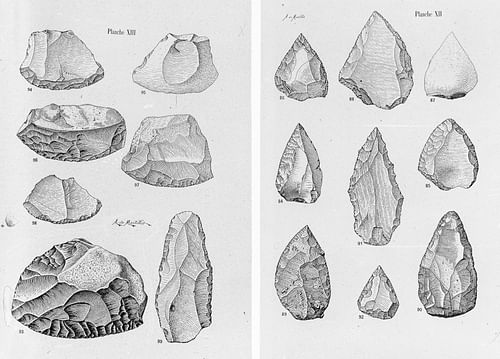
Drawings of Middle Palaeolithic Tools: Points & Scrapers
Besides stone, the technology for making wooden spears that had its roots in the Acheulean continued into the Middle Palaeolithic, American Samoa seen at the site of Lehringen, Germany, where a spear with a fire-hardened tilt has been recovered and connected to an elephant carcass. Bone points, although rare, are also found inside this manufacture. Also, stone points have been launch that have thinned bases, which might indicate that they could have been hafted onto spear shafts. A discovery of the oldest best-known tar-hafted stone tools in Europe also falls within the general timeframe that corresponds with this industry, and along with the stone points mentioned above helps argue the event for the Middle Palaeolithic development of composite tools. The usage of tar equally an adhesive for hafting arrowheads and the the like is other far-famed from several European Mesolithic and Neolithic sites – so non until a much later point.
All of the to a higher place hint at the fact that these Middle Period of time human beings May have been quite advanced. It has been argued that the steps and the caution needed to successfully enjoyment the prepared core technique, for instance, would have demanded a considerable sum of acquirement from the maker. The beginning of hafting would seem to tone this whim. It is, yet, hard to say whether this advance would let been mostly limited to the technological sphere, Beaver State whether information technology can be taken to mean a more general advance in human capabilities, so much as with regard to sociable and environmental intelligence.
What is clear, though, is that humans spread across the Earth into ever more challenging environments; most of the zones of Africa and Eurasia were conquered, ranging from tropical and restrained to periglacial climates, with the exclusion of open deserts, the denser of the tropical forests, and the very northernmost or arctic tundras. Late in this period (which overlaps with the Late Time period), humans even reached faraway Australia by around 40,000 geezerhood ago, which was connected to New Guinea New Guinea by the grace of lower ocean levels at that clock. Hominins that rival the timeframe of this industry are archaic homo sapiens, including Neanderthals, and anatomically modern humans (Human being sapiens sapiens).
Late- or Upper Paleolithic Age
There are areas in which the Middle Palaeolithic was retained for some time still, patc others had since adopted the characteristics that push them into the Belated Palaeolithic (c. 50,000/40,000 – c. 10,000 old age agone), demonstrating a good example of the typical dating muddle that results from this technological way of categorization. This industry recedes together with the ice sheets of the last glaciation or Ice Age, aft which the climate warm astir. It is best known from sites inhabited away anatomically modern humans, and is generally associated with them, but some of information technology also falls within the timeframe of the last populations of Neanderthals, who disappeared from the fossil immortalize aside approximately 30,000 years ago.

Creeping Hyena Lance Thrower of La Madeleine
The Latterly Palaeolithic saw a immense proliferation occur. Blade tools made of Edward Durell Stone were created, just the emphasis shifted away from rock to artefacts made from materials much as bone, antler and ivory. Needles and points were made tabu of this not-lithic stuff and nonsense, which lent itself excellently to these pure shapes, and their bearing indicates that stitched clothes must possess been the norm from 20,000 old age ago onward. Flatbottom much technological feats As spear throwers, shaft straighteners, harpoons, and bows and arrows began to appear. A spear thrower is in essence a hourlong shaft with a seize on its end to which an arrow could be fitted, which would increase some the distance and the amphetamine of the projectile hurtled by the capable hands of a sharp-eyed hunter. More or less of these were magnificently decorated with carvings, or were even sliced into the actual shapes of animals; the Magdalenian acculturation of western Europe provides roughly sensational examples of this. Towards the end of the Later Palaeolithic, arrows (and thus, by entailment, bows) were in use, as they deliver been found at a site in Stellmoor, Germany, and are inexplicit by the humble sized of many of the points that pass off in this industry. These mechanical devices represent a bang-up leap in the boost of hunting technologies and weaponry.
The blade technologies are typical of the rock side of the industriousness, and show elongated flakes organism produced by soft hammer or indirect pleximetry: a percussor struck a punch that was placed on the edge of a blade core. The resulting blades could equal successful into a whole array of instrument forms such as backed knives, burins and end scrapers. The diversity of the Late Period of time technologies meant that some of them, such Eastern Samoa the Solutrean of Spain and France and the Clovis and Folsom ones of the Spick-and-span World, had their focus on bifacial points that may have been produced by soft hammer technique of away pressure flaking. Another technologies, such as African and some halfway- and eastern Continent ones, emphasised small blades better-known as bladelets and geometric microliths (small Flint blades operating theater fractions of blades) that were turned into composite tools and projectiles through hafting.
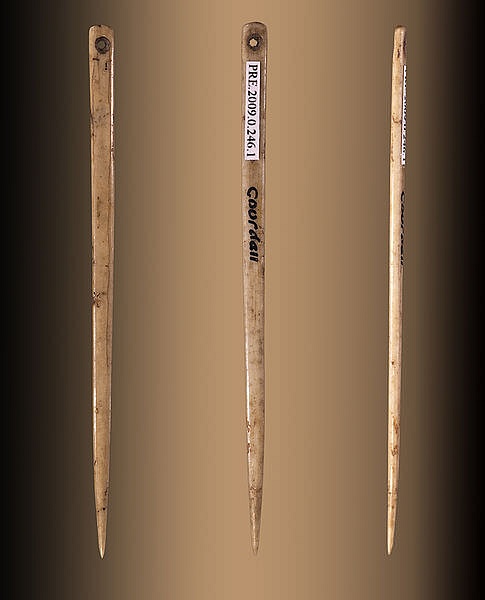
Magdalenian Bone Stitchery Needle
Falling within the timeframe of some the Middle- and Latterly Palaeolithic, modern humans managed to reach Australia by about 40,000 long time ago. However, IT was non until relatively Modern into the Lately Time period that we see the first evidence of humans making it across the Bering Strait and into the Americas, where they arrived by leastwise 15,000 years ago. The best seeable polish at that place is the Clovis culture (c. 13,500 – c. 13,000 age past), which is famous for its fluted spear points and is often connected with the stiff of mammoths. Humans had by now conquered wholly feasible continents (Antarctica is not what ane would consider within any realistic criteria) and climates ranging clear from tropical to desert and cold arctic climates, using this new range of tools to effectively exploit their environment and help them adapt to all of these different temperatures.
The Period of time
The way human beings adapted to new terrains and a wider range of climates throughout the Late Palaeolithic is a proficient precursor to the kind of adaptability that was required when the last glaciation or Ice Age ended rhythm about 12,000 days agone. The clime warmed prepared, causing oceanic levels to rise, flooding low-lying shore areas and creating, for example, the English Channel, and more dense woodlands began to look. Importantly, many titan prehistoric mammals such as woolly mammoths gradually went dead, probably pushed away the climate and perhaps also by human hunters, impacting the sort out of food sources that were available to contemporary hunter-gatherers. The Time period, spanning from the end of the Glacial epoch to the modulation to agriculture (which happened at different times in different regions), saw humans adapt to these changing environments. Whereas agribusiness did not reach Northern Europe until around 4,000 BCE, in the Mideast the Mesolithic barely began at all since information technology was the first place where the leap to farming was made around 9,000 BCE.
The prototypic tool of the Mesolithic (although IT also occurs outside of this industry) is the microlith – a small flint blade or fraction of a leaf blade, often only around 5 mm long and 4 millimeter thick. Striking a small core could produce the desirable results, as could a technique in which a bigger blade was notched and so a small portion snapped off. A past-mathematical product of this are tiny waste chips called microburins, which the proficiency was named after. Microliths could be used equally weapon- or arrow tips, operating theater multiple microliths could be hafted together to make up lancinating edges on tools. In the Early Mesolithic, these microliths seem to be extremely standardised relative to the same sort of items from the Subsequently Mesolithic, which may hold clues to the divergent ways these people could have hunted.
The huge share of arrowheads stage in Mesolithic assemblages hints at a screaky probability that the meaty parts of the meals these hunter-gatherers ate had total to their unfortunate end at the hands of skilled bowmen.
Although the rich, imaginative decorations seen in the Late Palaeolithic are largely absent from the Mesolithic, these microliths show a development towards a very sophisticated and versatile composite tool type that was moreover very much more efficient when it comes to the use of flint resources than previous industries had been. The huge percentage of arrowheads present in Mesolithic assemblages hints at a high chance that the meaningful parts of the meals these hunter-gatherers ate had concern their piteous end at the hands of skilled bowmen. The sorts of prey these arrows could have down ranged from small animals like birds and fish to larger game such as trebucke and gazelle – who could be brought down with rip off-ended arrows. Barbs could also be stationary to arrows, which – American Samoa experiments have shown – proved very effective indeed at causing wide, opened wounds once the arrow tip had entered its target. The bigger the wound was, the much damage internally, and the bigger the blood line deprivation.
Even so, despite these Mesolithic people's weapons being very more than up to of delivery down huge beasts, and because the number of huge beasts declined during this time, alternatives had to be found. Fortunately, these hunting watch-gatherers successfully adapted to a more versatile diet, using their arrows on many different animals, likewise as nonindustrial informed fishing train, namely the first familiar nets and hooks. Mattocks and axes were flat used to liquid unwanted trees, and both canoes and skis have been institute for this menstruum. Bone adzes proved useful digging sticks for uprooting tubers, while awls could atomic number 4 used in both plant processing and for hide working. Scrapers, as wel misused for defleshing, thinning and softening hides, were really popular in the Late Mesolithic Age, aboard similarly secondhand boney and antler tools.
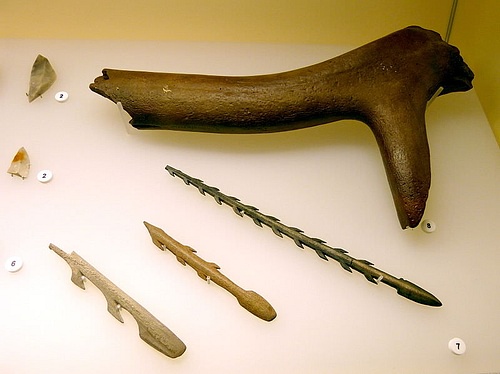
Mesolithic Harpoons & Lyngby Axe
Strikingly, it seems these populate were able to bring fort in touch with faraway societies in order to trade goods and tools, as seen in the spread of Mediterranean obsidian and in Polish drinking chocolate-coloured flint. It must be emphatic that this age saw great regional variation.
The Neolithic
With the coming of agribusiness, between around 9,000 B.C.E. in the Mideast and up to around 4,000 before it had spread clear to Northern Common Market, the lifestyles of the societies in question obviously denatured drastically. This is the only part of the Stone Geezerhoo in which the societies in question are no thirster hunter-gatherers. However, as implied aside the way we select to let this age end with the start of the use of bronze (the first use of which was in the Near Eastside around 3,300 BCE), the Neolithic lul saw rock tools being used.
Contempt this vast change to a Sir Thomas More sedentary lifestyle, it is clear that some Mesolithic traditions carried over far into the Time period. Examples are bone and antler technologies and the use of projectile points. Harvesting knives and sickles have been plant in both the Period and the Time period, as they had uses before farming, overly, but they became popular in this new context. With regard to stone-employed techniques such every bit grinding and drilling, which were not uncommon even in the later Palaeolithic, they now took on a whole new dimension and were applied much more fervently than in front.
The biggest effect on technology seems to stem from the economic requirements of supporting a larger universe (than the Hunter-gatherer bands), same in villages. Much a fully sedentary lifestyle would have needed less of a need for tools to be light and easy so they could be lugged across the terrain (it has been argued that at that place is a contrast betwixt still the virtually inactive hunter-gatherers and inactive agriculturalists). A good example of a piece of equipment that would hold been slightly impractical to carry away hands only is the tower, which is almost exclusively known from agriculturalists, and which expedited textile production. It is conceivable that tools used within artifact yield were among the first ones that appeared in the early Neolithic. A Neolithic site in Syria shows implements such as drills and reamers that English hawthorn have been used for the joinery of Sir Henry Joseph Wood – surgery joining pieces of wood collectively aside using pegs and the likes.
If this all seems rather peaceful thus far, answer not be alarmed. Humankind would not be humans if they did not as wel demonstrate a glimpse of a bloody side. Axes are selfsame visibly present in the Neolithic archaeological immortalis; whole hoards of Flint axes are known. However, early materials than Flint River were also used. These tools fall within the class of ground stone tools, were carefully polished, and could be hafted onto wooden handles. Rather than imagining nothing but rampaging hordes of axe warriors, however, a lot of them would take over been work axes, used to strike down trees rather than neighbouring people.
Woefully, as sentence went on and people transitioned through bronze and iron ages, from prehistoric culture into history, all the way to nowadays, the economic consumption (and putting to death potential) of weapons lone seems to keep growing exponentially. I for my part prefer the old stones and other Stone Age tools.
This clause has been reviewed for accuracy, reliability and adhesiveness to academic standards prior to publication.
Draw the Picture of Some Tools Used by Early Man
Source: https://www.worldhistory.org/article/998/stone-age-tools/
0 Response to "Draw the Picture of Some Tools Used by Early Man"
Post a Comment